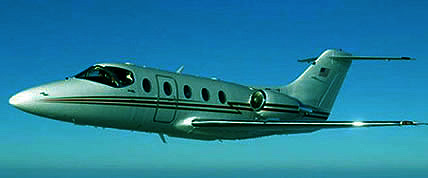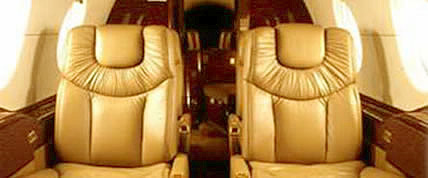
The Hawker 400 is a small twin-engine corporate jet. Initially designed and built by Mitsubishi, it has been further developed and upgraded by the Beech Aircraft Company, now part of Hawker Beechcraft.
 Originally the plane was designed as the Mitsubishi MU-300 Diamond,
an all-new, all-jet development to complement and provide a superior to
the Mitsubishi
MU-2 and supply Mitsubishi
Heavy Industries with their top-of-the-line corporate aircraft
model (hence the name "Diamond").[5]
The plane’s maiden flight was on 29 August 1978. It is a small,
low-winged twin-turbofan
aircraft of all metal construction, flown by a crew of two pilots and
accommodating eight passengers in a pressurized
cabin. Its wings use a computer designed, supercritical
airfoil in order to minimize drag. Its two Pratt
& Whitney Canada JT15D turbofans are mounted on the rear
fuselage.
Originally the plane was designed as the Mitsubishi MU-300 Diamond,
an all-new, all-jet development to complement and provide a superior to
the Mitsubishi
MU-2 and supply Mitsubishi
Heavy Industries with their top-of-the-line corporate aircraft
model (hence the name "Diamond").[5]
The plane’s maiden flight was on 29 August 1978. It is a small,
low-winged twin-turbofan
aircraft of all metal construction, flown by a crew of two pilots and
accommodating eight passengers in a pressurized
cabin. Its wings use a computer designed, supercritical
airfoil in order to minimize drag. Its two Pratt
& Whitney Canada JT15D turbofans are mounted on the rear
fuselage.
Beechcraft purchased the production rights and began producing it as their own model, initially re-designated as the Beechjet 400. The Beechjet 400 was certificated by the Federal Aviation Administration in May 1986.
Raytheon/Beechcraft gradually crafted their own improvements to the model, leading to the 400A in 1990. Upgrades to the 400A include further range, higher take-off weights and improved luxury appointments. An all-glass flight deck was also offered. Beechcraft also designed a version for the United States Air Force known as the T-1A Jayhawk, used as a trainer for large aircraft crews (such as tankers and strategic transports). A total of 180 T-1A trainers were delivered between 1992 and 1997. Another military variant is the Japan Air Self-Defense Force 400T trainer which shares the same Type Certificate as the T-1A.
 In 1993 Raytheon purchased the Hawker business jet product line from British
Aerospace. The Beechjet 400 was eventually renamed the Hawker
400 to map it into the Hawker product line. The Hawker 400XP
incorporates further aerodynamic, mechanical and interior upgrades
inspired by the Hawker
800XP.
In 1993 Raytheon purchased the Hawker business jet product line from British
Aerospace. The Beechjet 400 was eventually renamed the Hawker
400 to map it into the Hawker product line. The Hawker 400XP
incorporates further aerodynamic, mechanical and interior upgrades
inspired by the Hawker
800XP.
In October 2008, Hawker Beechcraft announced upgrades to the design, resulting in the new model designation Hawker 450XP. Upgrades were to include new, more fuel efficient engines (Pratt & Whitney PW535Ds with 2,965 pounds of thrust each). The Hawker 450XP was canceled in June 2009 due to poor economic conditions.
Nextant Aerospace developed a program to remanufacture the Beechjet 400A, replacing the Pratt & Whitney engines with Williams FJ44s, plus a new avionics suite and interior, among other improvements. The remanufactured aircraft, called the Nextant 400XT, received FAA certification in October 2011.
General Info |
||
|---|---|---|
| Category | Very light jet | |
| Crew | 2 | |
| Passengers | 7 standard, 9 maximum | |
| Max Speed | 861kmh | 465kts |
| Range | 2,883km | 1,557NM |
| URL | http://www.hawkerbeechcraft.com/ | |
| Powerplants | Two Pratt & Whitney Canada JT15D turbofan engines at 2,200 lbf/9,800 thrust each | |
Dimensions (External) |
||
| Wingspan | 13.26m | 43ft. 6in. |
| Wing area | 22.4m² | 241.12ft.² |
| Length | 14.76m | 48ft. 5in. |
| Height | 4.24m | 13ft. 11in. |
Dimensions (Internal) Cabin |
||
| Length | 4.72m | 15ft. 6in. |
| Width | 1.50m | 4ft. 11in. |
| Height | 1.45m | 4ft. 9in. |
| Baggage Capacity | ||
| Internal Volume | 0.57m³ | 20ft³ |
Weights |
||
| Basic Operating Weight | 4,982kgs | 10,985 lbs. |
| Max Ramp Weight | 7,484kgs. | 16,500lbs. |
| Max Takeoff Weight | 7,393kgs. | 16,300lbs. |
| Max Zero Fuel Weight | 5,896kgs. | 13,000lbs. |
| Max Landing Weight | 7,121kgs. | 15,700lbs. |
| Max Payload | 913kgs. | 2,015lbs. |
| Useful Load | 2,501kgs. | 5,515lbs. |
Performance |
||
| Cruise Speed | 833km/h | 450kts |
| Max Range | 2,883kms | 1,557nm |
| Max Operating Altitude | 13,716m | 45,000ft. |
| Takeoff Distance (sea level) | 1,190m | 3,906ft. |
| Landing Distance (sea level) | 1,071m | 3,514ft. |
http://www.jetadvisors.com/aircrafts/business-jet-hawker-400xp.htm

